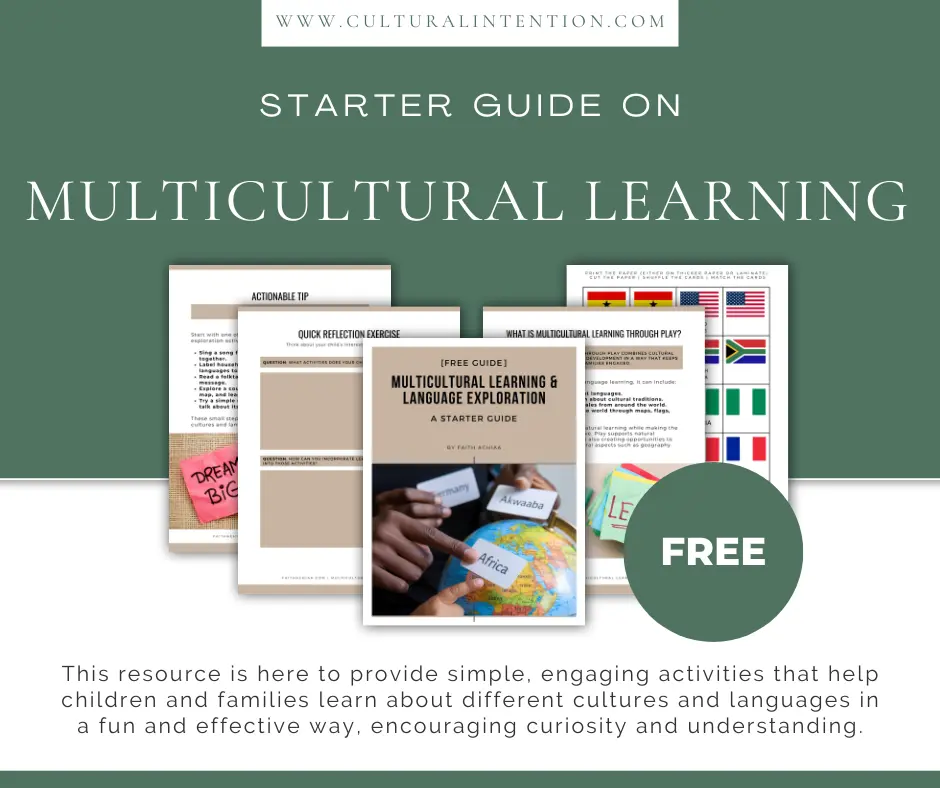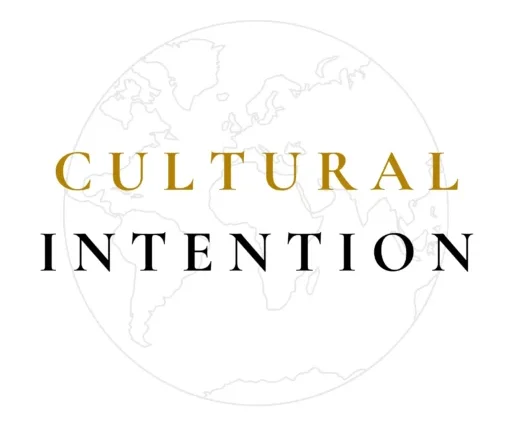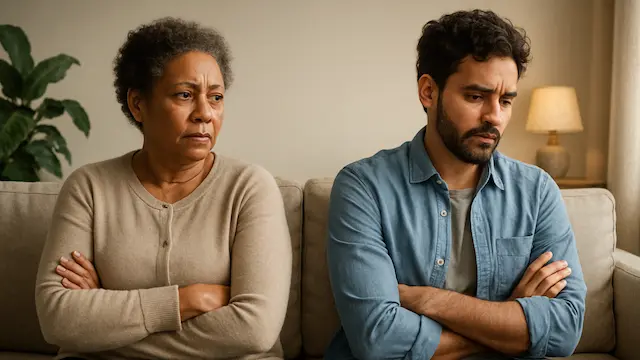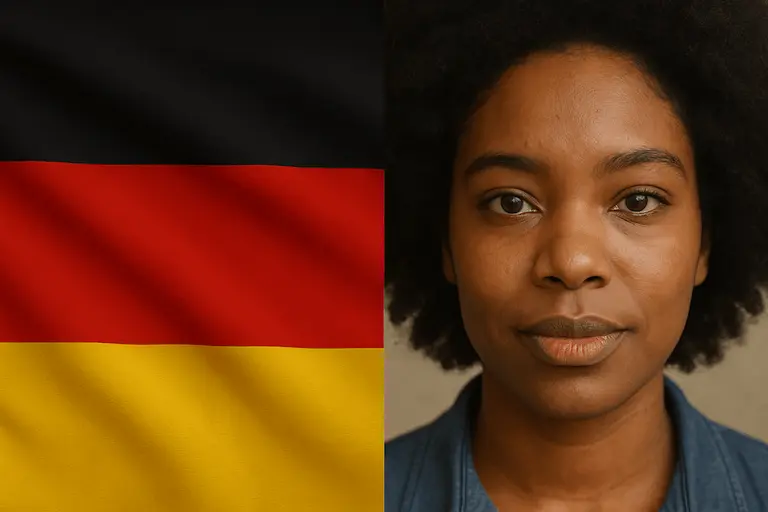9 Powerful Ways to Teach Multicultural and Multilingual Learning at Home + Free Guide

If you've ever found yourself switching languages mid-sentence, explaining your name’s meaning, or helping your kids pronounce a grandparent’s hometown correctly, you're already doing multicultural learning.
Whether you're navigating life across countries, helping your children connect with their roots, or simply wanting them to understand the world around them, multicultural learning helps raise self-aware and curious kids who connect well with others.
Here are a few examples of how multicultural and multilingual learning can manifest in everyday family life, including in our home.

Ready to Raise
Globally Minded Kids?
Download your FREE starter guide on Multicultural Learning & Language Exploration and help your children engage with the world through fun, hands-on activities.
1. Raising Multilingual Kids Is About More Than Language
When we say “multilingual,” it’s easy to picture kids fluent in multiple languages before preschool. And don’t get me wrong, some are, and that’s great.
But the reality is, many of us are struggling. Raising proud multilingual kids is often imperfect and all over the place.
It’s mixing languages at the dinner table. It’s teaching your child to say thank you in your mother tongue, even if they answer in English or their primary language, they feel comfortable in.
What’s helped us most is when our kids connect their words to people, places, and purpose, like greeting their grandparents in Twi, accents and all, or using a word they often hear us say, knowing it belongs to where we come from.
👉🏿 https://culturalintention.com/raising-proud-multilingual-kids/

2. You Don’t Have to Rely on Schools or Textbooks
When formal education doesn’t reflect your culture or your child’s roots, you can create what’s missing. This doesn’t mean turning your home into a full-time classroom.
It means turning small moments into learning moments on your terms. I was educated in Germany, my husband in Ghana, and our kids are now educated in the U.S.
Sometimes we wonder, “Why haven’t they learned this already?”, mainly because we learned things like world flags and country capitals much earlier. But every country teaches differently.
What’s standard in one place and culture might not be a focus in another. That’s why we’ve learned to fill in the gaps at home in natural and curious ways.
👉🏿 https://culturalintention.com/creating-your-own-cultural-learning-resources/
3. You Can Teach Language at Home Without a Formal Curriculum
It can feel very overwhelming when you want to raise bilingual or trilingual kids but don’t know where to start.
Many families think they need fancy apps or tutors. But most of the time, kids need consistency, exposure, and the proper context.
👉🏿 https://culturalintention.com/language-learning-at-home-bilingual-trilingual/
4. Using Everyday Words to Teach Connection and Culture
Multicultural learning includes more than facts, flags, or food. It also shapes how we connect with others and understand relationships.
That’s why learning simple words for connection, like greetings, thank you, love, mother, or friend, in different languages can build bridges naturally.
I always say our kids have their little “party tricks” of words they keep in their back pocket, depending on where we are. For our youngest, “Mutter” is the latest.
She’ll randomly say, “Mutter, have you eaten yet?” I smile and appreciate the effort; it reminds me that all the language moments we try to create are not in vain.
We’ve loved sharing some of these meaningful words in different languages on the website. You can explore a few below:
👉🏿 Earth in Different Languages
👉🏿 Friendship in Different Languages
👉🏿 Love in Different Languages
👉🏿 Queen in Different Languages
👉🏿 Warrior in Different Languages
👉🏿 Mom in Different Languages
👉🏿 Father in Different Languages

5. Play Is One of the Best Language Teachers
Structured lessons are helpful, but play teaches our kids just as much.
When language shows up during a board game, a made-up song, or pretend grocery shopping, kids pick it up without even realizing they’re learning.
👉🏿 https://culturalintention.com/preserve-language-through-family-play/
6. When Kids Reject Their Culture, It Doesn’t Mean You’ve Failed
One of the hardest parts of multicultural learning is when our kids seem uninterested in what we’re trying to pass down.
They might say they’re embarrassed to speak your language. Or they might choose to celebrate something like Halloween in a way that clashes with your values, making you wonder if they truly see the importance of what you’ve been trying to teach.
But that doesn’t mean you’ve failed. Identity takes time. And sometimes our kids hold onto parts we didn’t expect and let go of others we thought would stick.
The seeds we plant may grow differently than we imagined, but every little still matters.
👉🏿 https://culturalintention.com/when-kids-reject-your-culture/

7. Travel Isn’t Required—But World Awareness Still Matters
Not every family can hop on a plane to visit foreign lands. But every family can start conversations about the world.
We’ve done that through books and games that introduce geography, cultures, and people in ways our kids can actually connect with.
👉🏿 https://culturalintention.com/geography-books-and-games-for-kids/
8. Independence Day Can Be a Cultural Learning Moment
Celebrating holidays like Independence Day allows families to talk about their country’s history, their family’s personal story, and what freedom means to them.
It’s also a chance to learn how other countries gained independence, what traditions they celebrate, and how they remember their past.
These conversations open the door to values, legacy, immigration stories, and how different histories shape how people see the world.
In our family, these moments have brought up conversations we didn’t yet plan, like colonialism.
Our boys noticed that some countries, like the UK, Germany, or Belgium, don’t have an Independence Day, and that led us to talk about why.
It’s been such a learning journey for all of us, and honestly, it’s been amazing to teach them as we go.
👉🏿 https://culturalintention.com/celebrate-independence-day-family-tips/

9. You Can Raise Global Citizens With Simple Acts
You don’t need a doctorate in culture to raise kids who care about the world. But caring takes more than just knowing what’s around them.
Start with small habits: listening to music in different languages, trying recipes from other countries, or talking about global events in age-appropriate ways.
👉🏿 https://culturalintention.com/raising-global-citizens/
Download the Free Multicultural Learning Guide
If you're ready to keep learning in practical ways, this free guide is a great starting point. Inside, you’ll find:
- Easy activities to bring culture and language into your home
- Prompts to reflect on your family’s heritage and what you want to pass on
- Encouragement for when the journey feels messy or slow
👉🏿 https://culturalintention.com/FREEMulticulturalLearningGuide
Keep Exploring: Everyday Ways to Learn Culture and Language
The following posts continue the conversation and offer more ways to incorporate multicultural and multilingual learning into daily life.
From school settings to intergenerational wisdom, these examples show how identity, language, and cultural awareness shape how we live and learn at home and beyond.
We’ll keep adding more over time, so feel free to come back and explore.
👉🏿 School Culture Can Shape Student Success
👉🏿 Volunteer Ideas for Families
👉🏿 Learning Intergenerational Wisdom from Elders
👉🏿 Language Benefits in Code-Switching
👉🏿 Understanding Country History and Family Legacy
👉🏿 How to Handle Family Pressure When Raising Bilingual Kids
👉🏿 Raising Multicultural Kids: 9 Ways to Build Pride in Heritage and Embrace Home
Multicultural and multilingual learning takes time and often looks different from what we expected. But it’s still learning.
We give our families a strong foundation when we remain open to our approach, encourage questions, ask better questions, and make space for culture and language.
A foundation that does not go unnoticed, even if the results show up differently.
IF THIS POST SPOKE TO YOU, EXPLORE MORE OF THE JOURNEY ON OUR SITE.
You'll find free guides, intentional tools, and reflections to support cultural growth and legacy-building.
💬 Looking for connection? Join our Facebook community to continue the conversation.
📌 Pin an image to revisit or share with someone walking a similar path.
Thank you for being here.






